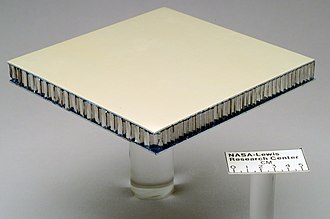
| Part of a series on |
| Continuum mechanics |
|---|
Sandwich theory[1][2] describes the behaviour of a beam, plate, or shell which consists of three layers—two facesheets and one core. The most commonly used sandwich theory is linear and is an extension of first-order beam theory. The linear sandwich theory is of importance for the design and analysis of sandwich panels, which are of use in building construction, vehicle construction, airplane construction and refrigeration engineering.
Some advantages of sandwich construction are:
- Sandwich cross-sections are composite. They usually consist of a low to moderate stiffness core which is connected with two stiff exterior facesheets. The composite has a considerably higher shear stiffness to weight ratio than an equivalent beam made of only the core material or the facesheet material. The composite also has a high tensile strength to weight ratio.
- The high stiffness of the facesheet leads to a high bending stiffness to weight ratio for the composite.
The behavior of a beam with sandwich cross-section under a load differs from a beam with a constant elastic cross section. If the radius of curvature during bending is large compared to the thickness of the sandwich beam and the strains in the component materials are small, the deformation of a sandwich composite beam can be separated into two parts
- deformations due to bending moments or bending deformation, and
- deformations due to transverse forces, also called shear deformation.
Sandwich beam, plate, and shell theories usually assume that the reference stress state is one of zero stress. However, during curing, differences of temperature between the facesheets persist because of the thermal separation by the core material. These temperature differences, coupled with different linear expansions of the facesheets, can lead to a bending of the sandwich beam in the direction of the warmer facesheet. If the bending is constrained during the manufacturing process, residual stresses can develop in the components of a sandwich composite. The superposition of a reference stress state on the solutions provided by sandwich theory is possible when the problem is linear. However, when large elastic deformations and rotations are expected, the initial stress state has to be incorporated directly into the sandwich theory.

